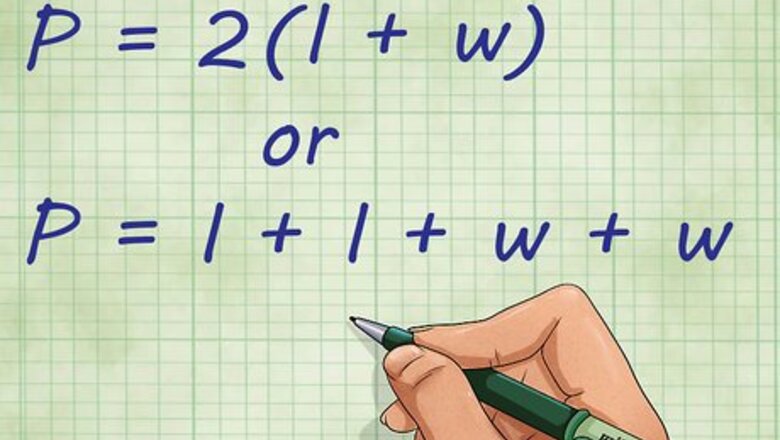
views
X
Research source
A rectangle is defined as a quadrilateral, or a geometric shape with four sides. In a rectangle, both sets of opposite sides are congruent, meaning that they are the same length.[2]
X
Research source
While not all rectangles are squares, all squares can be considered rectangles, and a compound shape may be composed of rectangles.[3]
X
Research source
Finding Perimeter with Length and Width
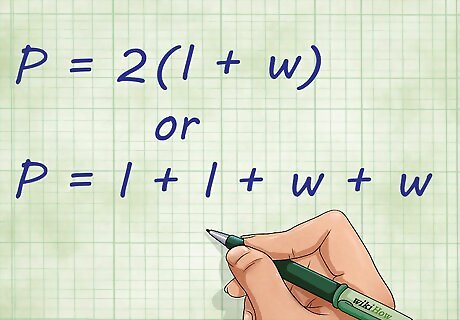
Write down the basic formula for finding the perimeter of a rectangle. This formula will help guide you as you calculate the perimeter of your own rectangle. The basic formula is: P = 2 * (l + w). Perimeter is always the total distance around the outside edge of any shape, whether it is simple or compound. In this equation, P stands for “perimeter,” l refers to the length of the rectangle, and w refers to the width of the rectangle. Length always has a greater value than width. Because opposite sides of a rectangle are equal, both lengths will be the same and both widths will be the same. This is why you write the equation as a multiplication of the sum of the length and width by 2. You can also write the equation as P = l + l + w + w to make this very clear.
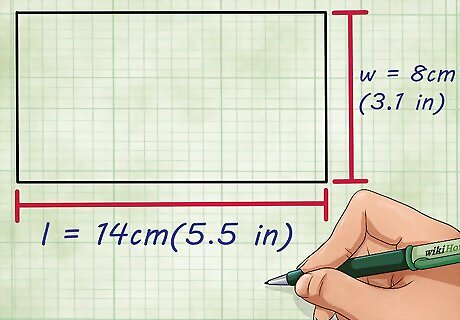
Find the length and the width of your rectangle. For a basic math problem at school, the length and width of the rectangle will be provided in the problem. These are usually next to the figure of the rectangle. If you are calculating the perimeter of a rectangle in real life, use a ruler, yardstick, or tape measure to find the length and width of the area that you are trying to measure. If you’re measuring outdoors, measure all sides to see if the opposites are truly congruent. For example, l = 14 centimeter (5.5 in), w = 8 centimeter (3.1 in).
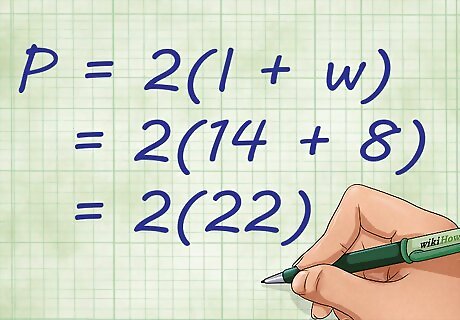
Add the length and width. After you identify your length and width, you want to plug them into the “l” and “w” slots in the perimeter equation. When you are working out your perimeter equations, note that according to the order of operations, mathematical expressions contained inside brackets or parentheses are solved before those outside of the parentheses. So, you’ll begin solving your equation by adding the length and width. For example, P = 2 * (l + w) = 2 * (14 + 8) = 2 * (22).
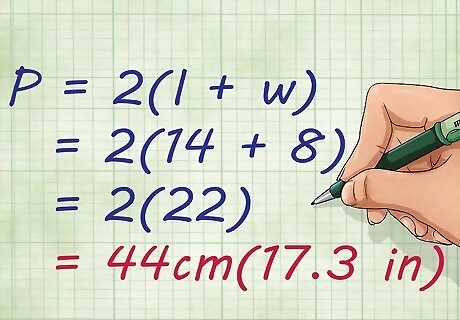
Multiply the sum of the length and width by two. When you’re looking the formula for the perimeter of a rectangle, the “(l + w)” is multiplied by two. Once you’ve completed this multiplication, you have the perimeter of your rectangle. This multiplication takes into account the other two sides of your rectangle. When you added together the width and length, you only added together two sides of the shape. Since the other two sides of the rectangle are equal to the two already added together, you can simply multiply this measurement by two in order to find the total sum of all four sides. For example, P = 2 * (l + w) = 2 * (14 + 8) = 2 * (22) = 44 centimeter (17.3 in).
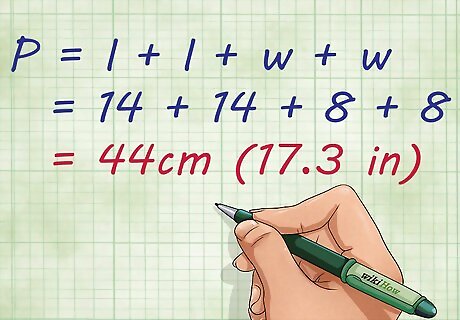
Add l + l + w + w. Instead of adding two sides of your rectangle and multiplying by two, you can simply add all four sides together directly to find the perimeter of your rectangle. If you struggle with the concept of perimeter, this is a great place to start. For example, P = l + l + w + w = 14 + 14 + 8 + 8 = 44 centimeter (17.3 in).
Calculating the Perimeter with Area and One Side
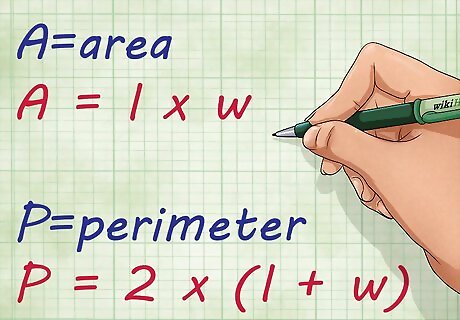
Write down the formula for area and the formula for the perimeter of a rectangle. Even though you already know the area of the rectangle in this problem, you will still need to use the area formula to find missing information. The area of a rectangle is a measurement of the two-dimensional space within the rectangle, or the number of square units within the rectangle. The formula used to find the area of a rectangle is A = l * w. The formula used to find the perimeter of a rectangle is P = 2 * (l + w) In the above formulas, A stands for “area,” P stands for “perimeter,” l refers to the length of the rectangle, and w refers to the width of the rectangle.
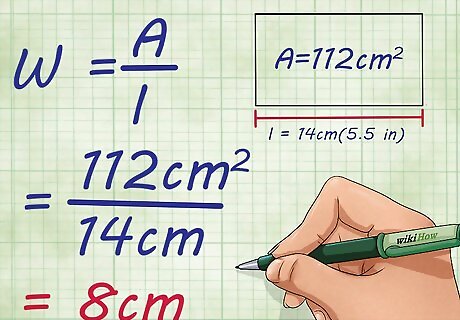
Divide the total area by the side measurement you know. This will allow you to find the measurement of the missing side of your rectangle, whether it is the length or the width. Finding this missing piece of information will then allow you to calculate perimeter. Because you multiply the length and width together to find the area, dividing the area by the width will give you the length. Likewise, dividing the area by the length will give you the width. For example, A = 112 centimeter (44.1 in) squared, l = 14 centimeter (5.5 in) A = l * w 112 = 14 * w 112/14 = w 8 = w
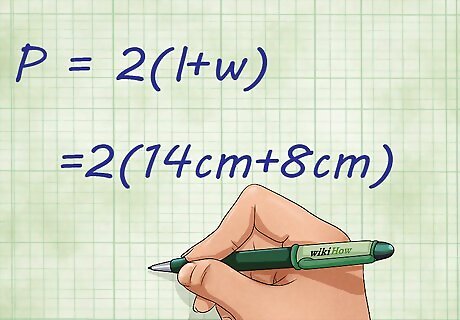
Add the length and width. Now that you have measurements for both the length and width, you can plug them into the formula for rectangular perimeter. In this problem, you add length and width together first because this part of the equation occurs in parentheses. According to the order of operations, you always do the part of the equation in parentheses first.
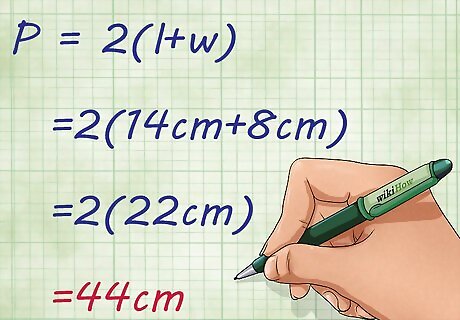
Multiply the sum of the length and width by two. Once you’ve added the length and width of your rectangle together, you can find its perimeter by multiplying by two. This takes into account the additional two sides of your rectangle. You are able to find the perimeter of the rectangle by adding length and width and multiplying by two because the opposite sides of a rectangle are equal in length. Both lengths of the rectangle are the same, and both widths are the same. For example, P = 2 * (14 + 8) = 2 * (22) = 44 centimeter (17.3 in).
Figuring Out the Perimeter of a Compound Rectangle
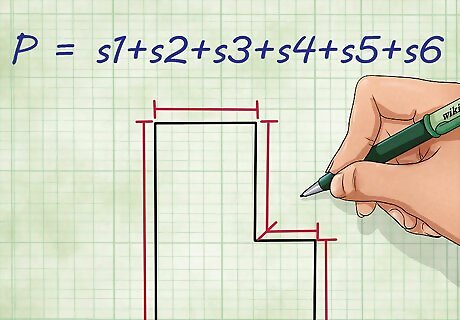
Write down the basic formula for perimeter. Perimeter is the sum total of all outer sides of any given shape, including irregular and compound shapes. A standard rectangle has four sides. The two sides composing the length are equal to each other, and the two sides composing the width are equal to each other. Therefore, the perimeter is the sum of those four sides. A compound rectangle has at least six sides. Think of a capital “L” or “T” shape. The top “branch” can be separated into one rectangle and the bottom “bar” can be separated into another. The perimeter of this shape, however, does not rely on breaking up the compound rectangle into two separate rectangles. Instead, the perimeter is simply: P = s1 + s2 + s3 + s4 + s5 + s6. Each “s” represents a different side of your compound rectangle.
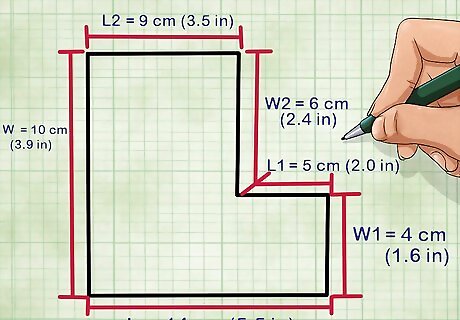
Find the measurement of each side. In a standard educational math problem, the measurement of all sides should be provided. This example uses the abbreviations L, W, l1, l2, w1, and w2. The uppercase L and W stand for the full lengths and widths of the shape. The lowercase ls and ws stand for the smaller lengths and widths. As such, the formula P = s1 + s2 + s3 + s4 + s5 + s6 equals P = L + W + l1 + l2 + w1 + w2. Variables, like “w” or “l” are simply placeholders for unknown numeric values. Example: L = 14 centimeter (5.5 in), W = 10 centimeter (3.9 in), l1 = 5 centimeter (2.0 in), l2 = 9 centimeter (3.5 in), w1 = 4 centimeter (1.6 in), w2 = 6 centimeter (2.4 in) Note that l1 and l2 will equal L. Similarly, w1 and w2 will equal W.
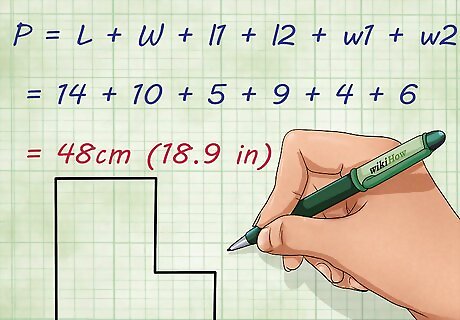
Add all the sides together. By plugging the numeric values of the sides into your equations, you’ll be able to find the perimeter of your compound shape. P = L + W + l1 + l2 + w1 + w2 = 14 + 10 + 5 + 9 + 4 + 6 = 48 centimeter (18.9 in)
Measuring the Perimeter of a Compound Rectangle with Limited Information
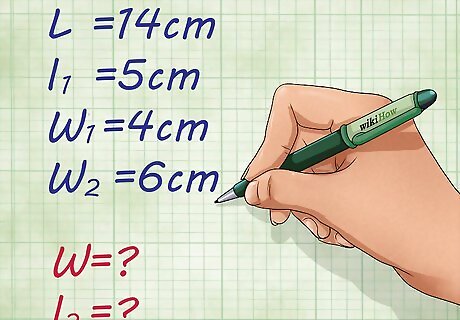
Organize the information you do have. You can still find the perimeter of a compound rectangle as long as you have at least one full length or full width and at least three of the minor width or length measurements. For an “L”-shaped compound rectangle, use the formula P = L + W + l1 + l2 + w1 + w2 In this formula, P stands for “perimeter.” The uppercase L and W stand for the full lengths and widths of the entire compound shape. The lowercase ls and ws stand for the smaller lengths and widths in the compound shape. Example: L = 14 centimeter (5.5 in), l1 = 5 centimeter (2.0 in), w1 = 4 centimeter (1.6 in), w2 = 6 centimeter (2.4 in); missing: W, l2
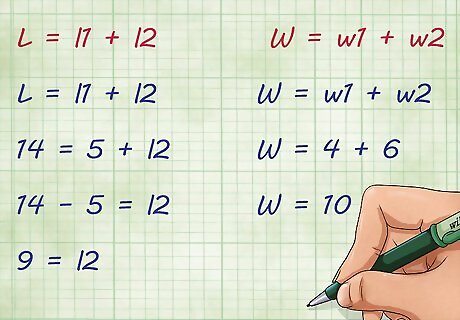
Use the measurements you have to find the missing side measurements. In this example, the full length, L, will be equal to the sum of l1 and l2. Likewise, the full width, W, will be equal to the sum of w1 and w2. Using this knowledge, add and subtract the measurements you do have to find the two missing measurements. Example: L = l1 + l2; W = w1 + w2 L = l1 + l2 14 = 5 + l2 14 – 5 = l2 9 = l2 W = w1 + w2 W = 4 + 6 W = 10
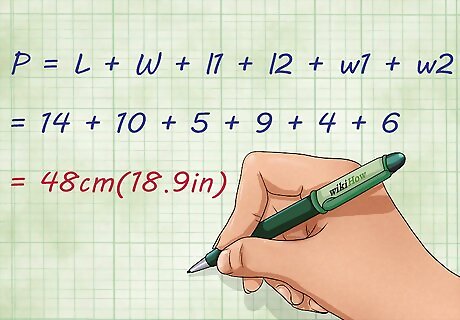
Add your sides together. Once you have subtracted to find your missing measurements, you can add all of your sides together to find the perimeter of the compound rectangle. Now, you’ll use the original perimeter formula. P = L + W + l1 + l2 + w1 + w2 = 14 + 10 + 5 + 9 + 4 + 6 = 48 centimeter (18.9 in)




















Comments
0 comment